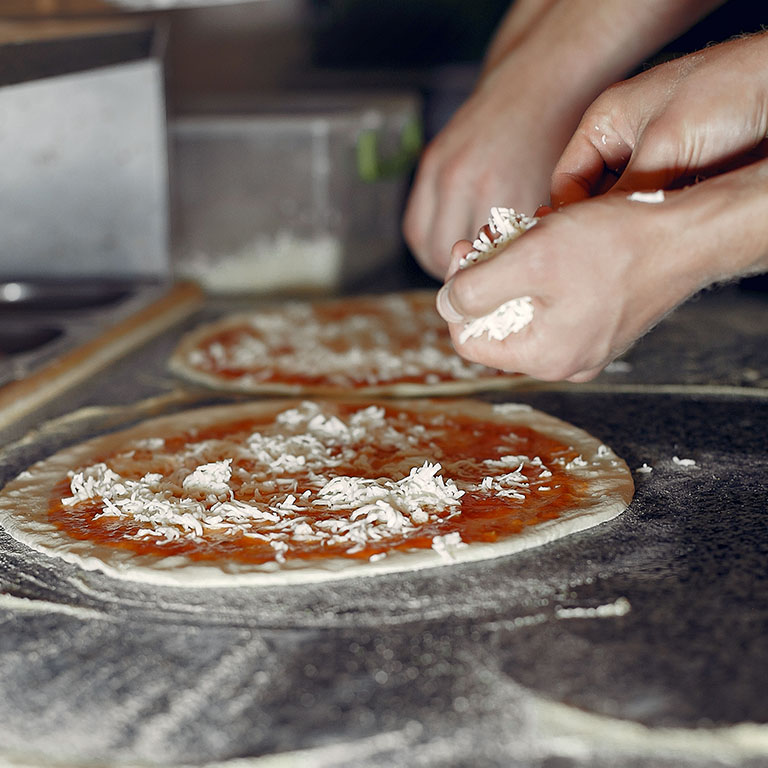World Pizza Day is celebrated on February 9th, and pizza is one of the most popular dishes worldwide. In 2017, UNESCO declared pizza an Intangible Cultural Heritage, recognizing its significance in social life and culinary heritage across generations.

The word “pizza” comes from the Greek word “pēktos,” which means solid or coagulated. It is one of the most iconic dishes in Italian cuisine, made with a circular baked dough consisting of wheat flour, salt, water, and yeast. It is topped with a base of tomato sauce and mozzarella cheese, and a variety of toppings can be added, such as onions, bell peppers, ham, pepperoni, anchovies, bacon, corn, or any other accompaniment preferred by the diner.
While the traditional way of cooking pizza is in a wood-fired oven, it is also very common to use domestic ovens. In addition, there are newer commercial presentations available, such as frozen pizzas or ready-to-bake options.
History of Pizza
Pizza has a fascinating history that dates back centuries. Its main precursor is related to the consumption of wheat bread in ancient cultures such as Egypt, Persia, Greece, and Rome. In the years 521–500 BC, Persian soldiers would nourish themselves with flatbread, melted cheese, and dates. In Ancient Rome, soldiers ate flatbread seasoned with olive oil and herbs.
The modern pizza, as we know it, with its base of dough covered in tomato sauce and melted cheese, has its roots in ancient Greek and Roman culture. However, it was in Italy where pizza truly began to take form. In the 17th century, specifically in Naples, Italy, pizza emerged as a popular dish as we know it today.
The first pizzeria, Port’Alba, opened in 1830 and remains open to this day. However, it wasn’t until Queen Margherita of Italy’s visit to Naples in 1889 that pizza began to gain international recognition. According to the story, pizzaiolo Raffaele Esposito prepared three different types of pizzas for her: one with tomato, mozzarella cheese, and basil, representing the colors of the Italian flag. The queen loved this combination, and since then, it has been named “Pizza Margherita” in her honor.
By the late 19th century, the people of Naples were consuming pizza for breakfast, lunch, and dinner. The art of pizza-making began to evolve, especially with the use of various ingredients. Pizzas were sold on the streets and later in dedicated establishments known as pizzerias.
In the early 20th century, the first Italian pizza in America was introduced in Chicago by street vendors walking along Taylor Street and selling hot slices of pizza to pedestrians. They kept the slices warm by storing them in cylindrical drums with a compartment filled with hot coals.

Evolution Throughout History
As pizza gained popularity, different styles and variations in its preparation began to emerge. Neapolitan pizza made its first appearance in the United States during World War II, when an article about pizza was published in the New York Times in 1944. It defined pizza as “a pie made of fermented dough filled with various ingredients, but always with tomato.” It was precisely here that the famous New York-style pizza developed, characterized by its thin and crispy crust and a generous number of toppings.
In the 1950s, the invention of frozen pizza allowed this dish to be consumed worldwide in a more convenient way. Today, we can find pizzas of all sizes, shapes, and flavors, from the traditional Margherita to Hawaiian pizzas with pineapple and ham.
Pizza in Different Cultures
Although pizza is considered an Italian dish, it has been adopted and adapted by different cultures around the world. In the United States, pizza has evolved to meet the tastes of each region. In Chicago, the famous deep-dish pizza style was created, with a thick crust and lots of cheese and sauce. In California, pizza has merged with Mexican cuisine, resulting in pizzas with ingredients like avocado and spicy sauce.
In Japan, pizza has been reinvented with unique ingredients such as seafood, squid, or soy cheese. Even in countries like India, a version of pizza has been created using traditional ingredients like curry and naan instead of the Italian bread crust.
Curious Facts About Pizza
- During the 18th century, the wife of the King of Naples, Queen Maria Carolina d’Asburgo-Lorena (1752–1814), had a special oven in her palace that was used to make pizzas.
- In 2012, in Rome, Italy, a pizza with a diameter of 1.13 kilometers was made. However, the world record for the longest pizza was established in 2016 in Naples, with a length of over 1.5 kilometers.
- Approximately 100 acres of pizza are consumed daily in the United States.
- The most expensive pizza in the world is in New York and costs an incredible sum of $2,500.
- The world record for pizza-making speed is 14.18 seconds.
- The Associazione Verace Pizza Napoletana protects and enhances the value of pizzas worldwide according to Neapolitan traditions. They are the only ones who can authenticate pizzas, which must meet characteristics such as a maximum diameter of 35 cm, puffy and elevated edges without burns, and a soft and fragrant texture.
In conclusion, pizza is a dish that has evolved throughout history and has been adopted by different cultures worldwide. Its popularity has grown exponentially, making it one of the most beloved meals in every corner of the planet. Let’s celebrate it every day, but especially on World Pizza Day. Enjoy!






